Corn Pests and Diseases Management for Sustainable Agriculture
- Biological Control
-
- Commodity name: Corn Pests and Diseases Management for Sustainable Agriculture
Corn is a vital crop for many farmers, but it is vulnerable to numerous pests and diseases that can significantly affect yield and quality. To address these challenges, recent advancements in agricultural science have focused on innovative strategies and tools for effective pest and disease management. Cutting-edge research has led to the development of genetically resistant corn varieties, precision agriculture technologies, and RNA interference (RNAi) methods that target specific pests. Additionally, new biological control agents, such as Bacillus thuringiensis (Bt), Trichoderma harzianum, entomopathogenic nematodes, and Beauveria bassiana, are proving to be effective and environmentally friendly alternatives to chemical pesticides. These trends in integrated pest management (IPM) are transforming how farmers protect their corn crops, ensuring healthier plants and more sustainable farming practices.
Early Identification of Most Common Corn Pests and Corn Diseases
Farmers identify the most common corn pests and diseases through regular field scouting and monitoring. This involves inspecting corn plants for signs of damage or disease symptoms, such as leaf discoloration, wilting, and visible pest activity. Technologies like drones and satellite imagery enhance these efforts by providing real-time data on crop health and identifying hotspots of infestation or infection early.
Biological controls are proving most effective for corn pests and diseases. Beneficial organisms like Bacillus thuringiensis (Bt) specifically target insect pests without harming non-target species, while fungi such as Trichoderma harzianum and Beauveria bassiana suppress disease pathogens and pest populations. Entomopathogenic nematodes effectively control soil-dwelling pests like corn rootworms. These biological agents, integrated into a comprehensive pest management strategy, offer sustainable and eco-friendly solutions for maintaining healthy corn crops.
Corn Pests
Corn Diseases
Anthracnose Leaf Blight and Stalk Rot (Colletotrichum graminicola)
Corn Nutrition
Corn Pests
Corn Earworm (Helicoverpa zea)
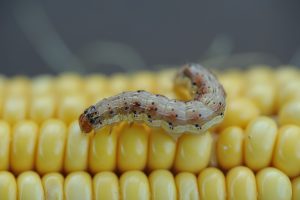
Features:
Corn earworms are voracious pests that predominantly target corn crops. These larvae are green, brown, or pink with longitudinal stripes and are easily identifiable by the yellow head capsule. Corn earworms primarily feed on corn ears, burrowing into the kernels and causing extensive damage.
Symptoms:
Corn plants infested with corn earworms show signs of feeding damage, including chewed kernels and frass (insect excrement) near the ear tips. This feeding can lead to secondary infections by fungi and bacteria, further compromising the quality and yield of the corn.
Management:
For biological control methods for corn earworms, encourage the presence of natural predators such as parasitic wasps, lacewings, and ladybugs. Crop rotation and the use of trap crops can also help manage earworm populations. For chemical control, apply insecticides such as Bacillus thuringiensis (Bt) or pyrethroids, but rotate treatments to prevent resistance. Regular monitoring and timely harvesting can reduce the impact of corn earworms on the crop.
Solution:
To manage corn earworm infestations effectively, a combined approach involving biological solutions can be highly effective. Products likeBt Thuricideoffer a sustainable solution. Bt Thuricide is a biological insecticide derived from Bacillus thuringiensis that specifically targets caterpillar pests like corn earworms by releasing toxins that disrupt their digestive systems, leading to their death. With a four-hour reentry interval, Bt Thuricide is safe for both farmers and the environment. By incorporating Bt Thuricide into an integrated pest management strategy, farmers can significantly reduce corn earworm populations and protect their crops from extensive damage. Regular application during the early stages of earworm infestation ensures optimal results, promoting healthier and more productive corn fields.
European Corn Borer (Ostrinia nubilalis)
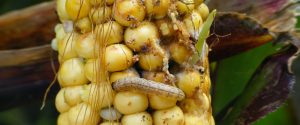
Features:
European corn borers are small moths with yellow-brown wings and dark wavy lines. The larvae are light pink or gray with dark spots and can grow up to 1 inch long. They bore into corn stalks, ears, and leaves, making them significant pests for corn crops.
Symptoms:
Infested corn plants exhibit small holes and tunnels in the stalks and leaves. These tunnels can weaken the plant, leading to breakage and reduced yield. Damaged ears may have chewed kernels and increased susceptibility to fungal infections.
Management:
Biological control includes introducing natural predators such as Trichogramma wasps and using Bacillus thuringiensis (Bt) corn varieties. Chemical control can involve insecticides like pyrethroids or organophosphates, but rotating these treatments is crucial to prevent resistance. Regular monitoring and destroying infested plant material can help manage European corn borer populations.
Solution:
To manage European corn borer infestations effectively, a combined approach involving biological solutions can be highly effective. Products like BT Thuricide offer a sustainable solution. Bt Thuricide is a biological insecticide derived from Bacillus thuringiensis that specifically targets caterpillar pests like European corn borers. The product releases toxins that disrupt the pest’s digestive system, leading to their death. With a four-hour reentry interval, Bt Thuricide is safe for both farmers and the environment. By incorporating Bt Thuricide into an integrated pest management strategy, farmers can significantly reduce European corn borer populations and protect their crops from extensive damage. Regular application during the early stages of infestation ensures optimal results, promoting healthier and more productive corn fields.
Fall Armyworm (Spodoptera frugiperda)
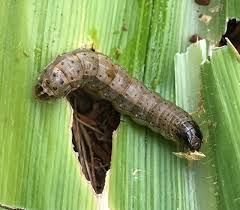
Features:
Fall armyworms are caterpillars that vary in color from green to brown with a distinctive inverted Y-shaped marking on their heads. They are highly destructive and can rapidly defoliate corn plants.
Symptoms:
Infested plants show ragged feeding damage on leaves, which can resemble windowpaning. The caterpillars may also burrow into ears, causing kernel damage and secondary infections.
Management:
Biological control methods include releasing beneficial insects like parasitoid wasps and applying Bt products. Chemical control can involve insecticides such as spinosad or chlorantraniliprole. Crop rotation and maintaining healthy soil can help reduce infestations. Early detection and prompt action are key to managing fall armyworms effectively.
Solution:
To manage fall armyworm infestations effectively, a combined approach involving biological solutions can be highly effective. Products likeBt Thuricideoffer a sustainable solution. Bt Thuricide is a biological insecticide derived from Bacillus thuringiensis that specifically targets caterpillar pests like fall armyworms by releasing toxins that disrupt their digestive systems, leading to their death. With a four-hour reentry interval, Bt Thuricide is safe for both farmers and the environment. Regular application of Bt Thuricide during the early stages of fall armyworm infestation can significantly reduce pest populations and protect corn crops from extensive damage. By incorporating Bt Thuricide into an integrated pest management strategy, farmers can promote healthier and more productive fields.
Western Corn Rootworm (Diabrotica virgifera virgifera)
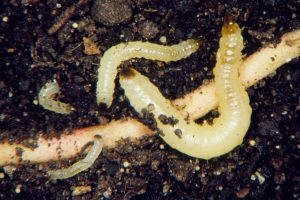
Features:
Western corn rootworms are yellow beetles with black stripes on their wings. The larvae are white with brown heads and feed on corn roots, causing significant damage to the plant’s ability to uptake water and nutrients.
Symptoms:
Infested plants may show stunted growth, lodging (falling over), and root damage. Severely damaged roots can lead to reduced plant stability and increased susceptibility to drought stress.
Management:
Crop rotation is an effective strategy to disrupt the life cycle of the rootworm. Biological controls include using entomopathogenic nematodes and predators like ground beetles. Chemical treatments can include soil-applied insecticides or seed treatments with neonicotinoids. Monitoring rootworm populations with sticky traps can help in making informed management decisions.
Solution:
To manage Western corn rootworm effectively, a combined approach involving biological and chemical solutions can be highly effective. MET Zone offers a powerful solution. MET Zone is a granular insecticide that targets soil-dwelling pests such as grubs, cutworms, and wireworms, which include the larvae of Western corn rootworm. Its active ingredients disrupt the feeding and development of these larvae, leading to their eventual death.
By applying MET Zone to the soil, farmers can protect corn roots from rootworm larvae, ensuring better root health and overall plant vigor. MET Zone’s granular formulation allows for easy application and targeted delivery to the root zone where larvae are most active. Incorporating MET Zone into an integrated pest management strategy helps reduce rootworm populations and minimize crop damage, promoting healthier and more productive corn fields.
Northern Corn Rootworm (Diabrotica barberi)

Features:
Northern corn rootworms are small, yellow-green beetles similar in appearance to the western corn rootworm but with subtle color differences. The larvae feed on corn roots, leading to significant plant damage.
Symptoms:
Infested corn plants exhibit stunted growth, lodging, and root pruning. The damage to the root system reduces the plant’s ability to absorb water and nutrients, leading to poor yields.
Management:
Implementing crop rotation is crucial for managing northern corn rootworm populations. Biological controls include the use of beneficial nematodes and predatory beetles. Chemical control can involve seed treatments or soil-applied insecticides. Monitoring adult beetle populations can help determine the need for control measures.
Solution:
To manage northern corn rootworm effectively, integrating biological solutions can be highly effective. Products like MET Zone and Metarhizium anisopliae offer sustainable options.
MET Zone:
MET Zone is a granular insecticide that provides targeted control of root-feeding pests, including northern corn rootworm larvae. It delivers active ingredients directly to the root zone, ensuring effective pest management. By incorporating MET Zone into your pest control strategy, you can protect corn roots from severe damage, enhancing plant health and productivity.
Metarhizium anisopliae:
Metarhizium anisopliae is a beneficial fungus that acts as a biological control agent against northern corn rootworm. This entomopathogenic fungus infects and kills rootworm larvae, reducing their population naturally. The fungus colonizes the soil, creating a protective barrier around corn roots and promoting a healthier root system. Regular application of Metarhizium anisopliae can help maintain low rootworm populations and protect your corn crop from extensive damage.
By combining these products with an integrated pest management approach, including crop rotation, resistant hybrids, and regular monitoring, farmers can effectively manage northern corn rootworm and safeguard their corn fields.
Southern Corn Rootworm (Diabrotica undecimpunctata howardi)
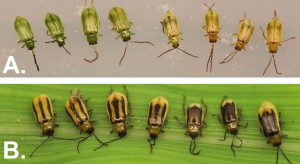
Features:
Southern corn rootworms, also known as spotted cucumber beetles, are greenish-yellow beetles with 12 black spots on their wings. The larvae feed on corn roots, causing damage similar to other rootworm species.
Symptoms:
Affected plants may show signs of root pruning, stunted growth, and increased lodging. The damage to the root system can lead to reduced water and nutrient uptake, impacting overall plant health and yield.
Management:
Crop rotation is an effective strategy to manage southern corn rootworm populations. Biological controls include beneficial nematodes and predatory beetles. Chemical control can involve the use of seed treatments or soil-applied insecticides. Monitoring beetle populations and using pheromone traps can help in making timely control decisions.
Solution:
To manage Southern Corn Rootworm infestations effectively, a combined approach involving biological solutions can be highly effective. Products like MET Zone and Metarhizium anisopliae offer sustainable solutions.
MET Zoneis a granular insecticide that targets soil-dwelling pests such as grubs, cutworms, and wireworms, which are often associated with rootworm infestations. MET Zone provides a protective barrier in the soil, reducing the population of these damaging pests and safeguarding the corn roots.
Similarly, Metarhizium anisopliae is a beneficial fungus that acts as a biological control agent. It infects and kills rootworms and other soil pests by penetrating their exoskeleton and proliferating inside their bodies. This fungus is an environmentally friendly option that reduces pest populations without harming non-target organisms or the environment.
By incorporating MET Zone and Metarhizium anisopliae into an integrated pest management strategy, farmers can effectively control Southern Corn Rootworm populations. Regular application during the early stages of infestation ensures optimal results, promoting healthier and more productive corn fields. These solutions not only protect the crop from extensive damage but also support sustainable agricultural practices.
Corn Leaf Aphid (Rhopalosiphum maidis)
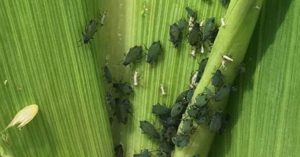
Features:
Corn leaf aphids are small, soft-bodied insects that can be green, blue-green, or black. They cluster on the upper leaves and tassels of corn plants, sucking sap and excreting honeydew, which can attract sooty mold.
Symptoms:
Infested plants may exhibit yellowing, curling leaves, and stunted growth. The presence of honeydew and sooty mold can reduce photosynthesis, further weakening the plant.
Management:
Biological control methods include introducing natural predators like ladybugs, lacewings, and parasitic wasps. Chemical controls can involve insecticidal soaps or horticultural oils. Regular monitoring and promoting plant health through proper fertilization and watering can help manage corn leaf aphid populations.
Solution:
To manage corn leaf aphid infestations effectively, a combined approach involving biological solutions can be highly effective. Products like BEVERIA WP and Beauveria bassiana offer sustainable solutions. BEVERIA WP contains Beauveria bassiana, a beneficial fungus that acts as a biological control agent by infecting and killing aphids. This fungus works by attaching to the aphids’ cuticle, penetrating their bodies, and proliferating inside, ultimately leading to the aphids’ death.
Similarly, Beauveria bassiana is a microbial insecticide that targets a wide range of insect pests, including corn leaf aphids. It can be applied as a foliar spray, and once it contacts the aphids, it begins to infect and kill them, reducing the population effectively. Using these biological control products as part of an integrated pest management strategy helps to minimize the reliance on chemical insecticides, promoting a more environmentally friendly approach to pest control.
Regular application of BEVERIA WP or Beauveria bassiana during the early stages of aphid infestation ensures optimal results, protecting the corn crops from extensive damage. By incorporating these biological solutions into their pest management practices, farmers can promote healthier and more productive corn fields.
Corn Root Aphid (Anuraphis maidi-radicis)
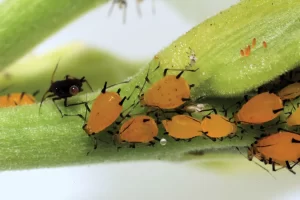
Features:
Corn root aphids are tiny, white to pale green insects that feed on corn roots. They are often found in association with ants, which protect them in exchange for the honeydew they produce.
Symptoms:
Infested plants show signs of stunted growth, yellowing leaves, and poor root development. Severe infestations can lead to plant wilting and reduced yields.
Management:
Managing ant populations can help control corn root aphids, as ants protect and transport aphids. Biological controls include entomopathogenic fungi and beneficial nematodes. Chemical control can involve soil-applied insecticides. Maintaining healthy soil and practicing crop rotation can also help reduce aphid infestations.
Solution:
To manage corn root aphid infestations effectively, a combined approach involving biological solutions can be highly effective. Products like BEVERIA WP and Beauveria bassiana offer sustainable solutions. BEVERIA WP is a wettable powder formulation containing the beneficial fungus Beauveria bassiana. This fungus acts as a biological control agent by infecting and killing aphids through contact, leading to their death within days. Beauveria bassiana is particularly effective because it not only targets aphids but also helps to suppress other soil-dwelling pests.
By incorporating BEVERIA WP and Beauveria bassiana into an integrated pest management strategy, farmers can significantly reduce corn root aphid populations and protect their crops from extensive damage. Regular application of these biological products during the early stages of infestation ensures optimal results, promoting healthier and more productive corn fields. For more information about BEVERIA WP and Beauveria bassiana, you can visit the BEVERIA WP product pageand the Beauveria bassiana product page.
Corn Flea Beetle (Chaetocnema pulicaria)
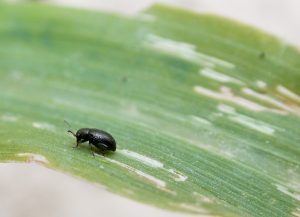
Features:
Corn flea beetles are small, black or dark brown beetles known for their jumping ability. They feed on corn leaves, creating small, round holes and transmitting Stewart’s wilt disease.
Symptoms:
Infested plants show signs of feeding damage on leaves, which appear as small, shot-hole patterns. If Stewart’s wilt is transmitted, plants may exhibit wilting, stunted growth, and yellow streaks on leaves.
Management:
Biological control methods include encouraging natural predators like ground beetles and spiders. Chemical control can involve foliar insecticides or seed treatments. Monitoring flea beetle populations and using resistant corn varieties can help manage infestations.
Solution:
To manage corn flea beetle infestations effectively, a combined approach involving biological solutions can be highly effective. Products like Myco Pestop offer a sustainable solution. Myco Pestop is a biological insecticide derived from the entomopathogenic fungus Metarhizium anisopliae. This fungus infects and kills a wide range of insect pests, including corn flea beetles, by penetrating their exoskeleton and proliferating inside their bodies.
Applying Myco Pestop helps control corn flea beetle populations by targeting them at various life stages. With its organic formulation, Myco Pestop is safe for beneficial insects, humans, and the environment. Regular application, especially during the early stages of beetle activity, can significantly reduce flea beetle numbers and protect corn crops from extensive damage. By incorporating Myco Pestop into an integrated pest management strategy, farmers can achieve healthier and more productive corn fields.
Black Cutworm (Agrotis ipsilon)
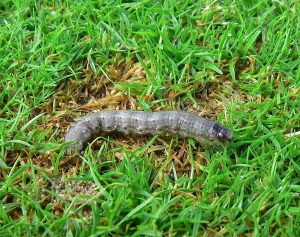
Features:
Black cutworms are dark gray or black caterpillars that can grow up to 2 inches long. They are nocturnal feeders, cutting down young corn plants at or just below the soil surface.
Symptoms:
Infested fields show plants cut off at the base, often with the severed plants lying on the ground. This damage can result in significant stand loss and reduced yields.
Management:
Biological control methods include using beneficial nematodes and encouraging natural predators like birds and ground beetles. Chemical control can involve applying insecticides to the soil surface. Monitoring for cutworm activity and using pheromone traps can help in timely application of control measures.
Solution:
To manage black cutworm infestations effectively, a combined approach involving biological solutions can be highly effective. Products like MET Zone and Metarhizium anisopliae offer sustainable solutions.
MET Zone: This granular insecticide is specifically designed to target soil-dwelling pests like black cutworms. MET Zone contains beneficial microbes that produce toxins lethal to cutworms upon ingestion. Its granular form ensures easy application and long-lasting protection by creating a protective barrier around the seedlings. Regular application during the early stages of crop growth can significantly reduce cutworm damage.
Metarhizium anisopliae: Metarhizium anisopliae is a beneficial fungus that acts as a biological control agent against black cutworms. This fungus infects and kills the cutworms by penetrating their cuticle and proliferating inside their bodies. It is an environmentally friendly alternative to chemical pesticides, promoting sustainable agriculture. Applying Metarhizium anisopliae to the soil can effectively reduce cutworm populations and prevent future infestations.
By incorporating MET Zone and Metarhizium anisopliae into an integrated pest management strategy, farmers can achieve effective control of black cutworms, ensuring healthier and more productive corn crops.
Common Stalk Borer (Papaipema nebris)
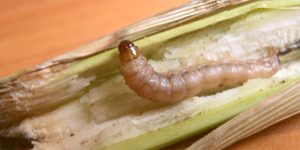
Features:
Common stalk borers are larvae of moths that have purple and white stripes along their bodies. They bore into corn stalks, causing significant internal damage.
Symptoms:
Infested plants exhibit wilting, stunted growth, and dead central leaves (dead heart). Bored stalks may break easily, reducing plant stability and yield.
Management:
Biological control includes releasing parasitic wasps and encouraging predators like birds. Chemical control can involve foliar insecticides, but timing is critical for effectiveness. Mowing and removing weeds near corn fields can reduce stalk borer habitats. Regular monitoring and destroying infested plants can help manage stalk borer populations.
Solution:
To manage common stalk borer infestations effectively, a combined approach involving biological solutions can be highly effective. Products likeBt Thuricideoffer a sustainable solution. Bt Thuricide is a biological insecticide derived from Bacillus thuringiensis that specifically targets caterpillar pests like common stalk borers by releasing toxins that disrupt their digestive systems, leading to their death. With a four-hour reentry interval, Bt Thuricide is safe for both farmers and the environment. By incorporating Bt Thuricide into an integrated pest management strategy, farmers can significantly reduce common stalk borer populations and protect their crops from extensive damage. Regular application during the early stages of borer activity ensures optimal results, promoting healthier and more productive corn fields.
Corn Sap Beetle (Carpophilus dimidiatus)
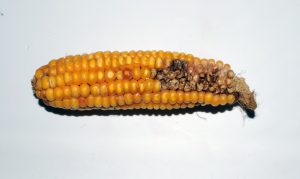
Features:
Corn sap beetles are small, oval-shaped beetles that are brown to black with lighter colored wing covers. They feed on damaged corn kernels and are attracted to fermenting plant material.
Symptoms:
Infested ears show signs of feeding damage on kernels, which can lead to mold and rot. The presence of beetles can further reduce the marketability of the corn.
Management:
Maintaining good field sanitation and promptly harvesting mature corn can reduce sap beetle infestations. Biological controls include natural predators like birds and predatory beetles. Chemical control can involve applying insecticides to the soil surface or using bait traps. Proper storage practices can also help prevent infestations in stored corn.
Solution:
To manage corn sap beetle infestations effectively, a combined approach involving biological solutions can be highly effective. Products likeMyco Pestopoffer sustainable solutions. Myco Pestop is an organic insecticide derived from Metarhizium anisopliae, a naturally occurring fungus that targets and infects beetles, leading to their death. This biological control agent is safe for both farmers and the environment and works by colonizing the beetles, disrupting their life cycle, and reducing their population. By incorporating Myco Pestop into an integrated pest management strategy, farmers can significantly reduce corn sap beetle populations and protect their crops from extensive damage. Regular application ensures optimal results, promoting healthier and more productive corn fields.
Corn Silk Beetle (Meligethes aeneus)
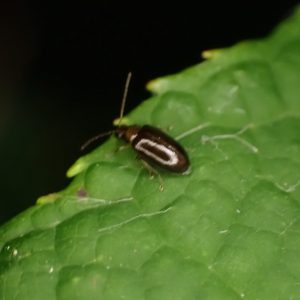
Features:
Corn silk beetles are small, shiny beetles that are usually black or dark blue. They feed on corn silks, which can interfere with pollination and reduce kernel development.
Symptoms:
Infested plants show damaged or clipped silks, leading to poor pollination and kernel set. This damage can significantly impact corn yield and quality.
Management:
Encouraging natural predators like ladybugs and parasitic wasps can help control corn silk beetle populations. Chemical control can involve foliar insecticides, but should be timed to protect pollination. Monitoring silk damage and using resistant corn varieties can help manage infestations.
Solution:
To manage corn silk beetle infestations effectively, a combined approach involving biological solutions can be highly effective. Products like BEVERIA WP and Beauveria bassiana offer sustainable solutions. BEVERIA WP is a biological insecticide derived from the fungus Beauveria bassiana, which infects and kills a wide range of insect pests, including corn silk beetles. This product works by penetrating the beetle’s cuticle and proliferating inside, leading to the insect’s death. Similarly, Beauveria bassiana acts as a biological control agent, targeting and eliminating beetles while being safe for non-target organisms and the environment.
By incorporating BEVERIA WP and Beauveria bassiana into an integrated pest management strategy, farmers can effectively reduce corn silk beetle populations and protect their crops from extensive damage. Regular application, especially during the early stages of beetle infestation, ensures optimal results, promoting healthier and more productive corn fields. For more information aboutBEVERIA WP, you can visit the product page. To learn more about Beauveria bassiana, visit the product page.
Corn Diseases
Northern Corn Leaf Blight (Exserohilum turcicum)
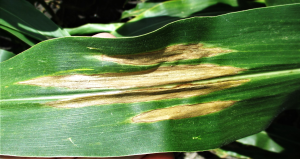
Features:
Northern Corn Leaf Blight, caused by the fungus Exserohilum turcicum, is a significant disease affecting corn plants. It thrives in areas with moderate temperatures and high humidity, making it a common issue in many corn-growing regions. The pathogen can survive in plant debris, facilitating its persistence and spread.
Symptoms:
Northern Corn Leaf Blight is characterized by the appearance of long, elliptical lesions on the leaves of corn plants. These lesions are typically gray to tan in color and can be several inches long. As the disease progresses, the lesions may coalesce, leading to extensive leaf blighting. Infected leaves become necrotic, reducing the plant’s photosynthetic capacity. Severely affected plants may exhibit premature leaf senescence, reduced ear size, and overall yield loss.
Management:
Effective management of Northern Corn Leaf Blight involves a combination of cultural practices and chemical treatments. Rotate corn with non-host crops to break the disease cycle and reduce inoculum levels in the field. Use resistant corn hybrids to minimize susceptibility to the disease. Implement proper crop residue management by tilling under plant debris to decrease the survival of the pathogen. Ensure adequate plant spacing and proper fertilization to enhance plant vigor and reduce stress. Fungicide applications can be used preventively, especially during favorable conditions for disease development. Products containing active ingredients like strobilurins or triazoles are effective, but their use should be timed appropriately and rotated to prevent resistance. Regular scouting and early detection are crucial for timely intervention and reducing the impact of Northern Corn Leaf Blight on corn crops.
Solution:
To manage Northern Corn Leaf Blight effectively, a combined approach involving biological solutions can be highly effective. Products like METILOandTrianum-Voffer sustainable and innovative solutions.
METILO:
METILO is a microbial biostimulant that enhances plant health and resilience by promoting root development and nutrient uptake. This biostimulant contains beneficial microbes that improve soil health and boost the plant’s natural defenses against pathogens. By strengthening the corn plant’s overall health, METILO helps in mitigating the impact of diseases like Northern Corn Leaf Blight.
Trianum-V:
Trianum-V is a foliar spray fungicide that contains the beneficial fungusTrichoderma harzianum. This product acts as a biological control agent, combating the fungal pathogens that cause Northern Corn Leaf Blight.Trichoderma harzianumcolonizes the plant’s leaf surface, outcompeting harmful fungi and stimulating the plant’s immune response. By using Trianum-V, farmers can protect their corn crops from NCLB while reducing the reliance on chemical fungicides.
By integrating METILO and Trianum-V into a comprehensive disease management strategy, corn farmers can effectively minimize the impact of Northern Corn Leaf Blight, ensuring healthier plants and more productive yields.
Southern Corn Leaf Blight (Bipolaris maydis)
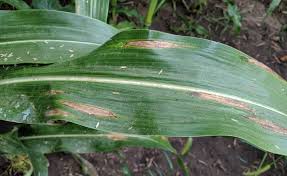
Features:
Southern Corn Leaf Blight, caused by the fungus Bipolaris maydis, thrives in warm, humid environments, making it a prevalent disease in southern corn-growing regions. The pathogen can overwinter in crop debris, facilitating its persistence and spread.
Symptoms:
The disease manifests as small, tan to brown lesions with distinct reddish-brown borders on corn leaves. As the lesions coalesce, they can cause extensive leaf blight. In severe cases, the affected leaves may dry out completely, leading to reduced photosynthesis, stunted plant growth, and significant yield loss.
Management:
Effective management involves crop rotation with non-host plants and using resistant corn hybrids to minimize susceptibility. Implementing good crop residue management practices, such as deep plowing, can reduce the inoculum level. Fungicide applications, especially during conditions favorable for disease development, can help control the spread. Products containing strobilurins or triazoles are effective. Regular scouting and early detection are crucial for timely intervention and reducing the impact of Southern Corn Leaf Blight.
Solution:
To manage Southern Corn Leaf Blight effectively, incorporating biological solutions like METILO and Trianum-V can be highly effective.
-
METILO:
METILOis a microbial biostimulant that enhances plant growth and resilience. It contains beneficial microorganisms that improve nutrient uptake, stimulate root development, and strengthen the plant’s natural defenses against pathogens. By promoting overall plant health, METILO helps corn plants better withstand the stresses caused by Southern Corn Leaf Blight, reducing the disease’s impact on yield and quality.
-
Trianum-V:
Trianum-Vis a foliar spray fungicide containing Trichoderma, a beneficial fungus that acts as a biological control agent. Trichoderma outcompetes and parasitizes harmful fungi like Bipolaris maydis, the pathogen responsible for Southern Corn Leaf Blight. Applying Trianum-V as a foliar spray creates a protective barrier on the leaf surface, reducing the incidence and severity of the disease. Additionally, Trichoderma enhances the plant’s immune response, making it more resilient to fungal infections.
By incorporating METILO and Trianum-V into an integrated disease management strategy, corn growers can effectively reduce the impact of Southern Corn Leaf Blight. Regular application of these biological products, combined with cultural practices and resistant varieties, ensures healthier and more productive corn fields.
Gray Leaf Spot (Cercospora zeae-maydis)
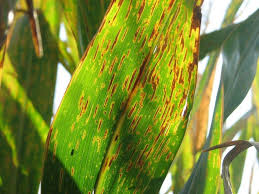
Features:
Gray Leaf Spot, caused by the fungus Cercospora zeae-maydis, is a common foliar disease in corn that thrives in warm, humid conditions. The pathogen survives in crop debris, making it a persistent problem in continuous corn cropping systems.
Symptoms:
The disease is characterized by the development of rectangular, gray to tan lesions on the leaves. These lesions are often surrounded by a yellow halo and can coalesce, leading to extensive leaf blight. Severe infections can reduce photosynthetic area, causing premature leaf senescence and significant yield loss.
Management:
To manage Gray Leaf Spot, rotate corn with non-host crops to break the disease cycle. Use resistant hybrids and ensure proper crop residue management to reduce pathogen survival. Fungicide applications can be effective, particularly during periods of high disease pressure. Products containing strobilurins, triazoles, or a combination can be used. Regular monitoring and timely application of fungicides are essential for effective control.
Solution:
To manage Gray Leaf Spot effectively, a combined approach involving biological solutions can be highly effective. Products like Bacillus amyloliquefaciens offer sustainable solutions. Bacillus amyloliquefaciens is a beneficial bacterium that promotes plant health by colonizing the root zone and providing a protective barrier against pathogens. It produces antimicrobial compounds that inhibit the growth of fungal pathogens, including those causing Gray Leaf Spot. Additionally, Bacillus amyloliquefaciens stimulates the plant’s immune system, enhancing its natural defense mechanisms.
By incorporating Bacillus amyloliquefaciens into a comprehensive disease management strategy, corn growers can minimize the impact of Gray Leaf Spot and promote healthier, more productive crops. Regular application of this biological control agent, particularly during periods conducive to disease development, ensures optimal protection. For more information about Bacillus amyloliquefaciens, you can visit the product page.
Common Rust (Puccinia sorghi)
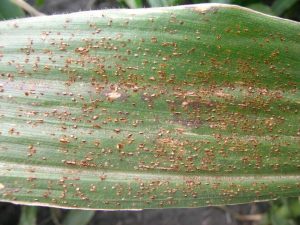
Features:
Common Rust, caused by the fungus Puccinia sorghi, is prevalent in temperate corn-growing regions. The disease thrives in cool, moist conditions and can significantly impact corn yield and quality.
Symptoms:
Common Rust is characterized by the presence of small, reddish-brown pustules on both leaf surfaces. These pustules contain spores that can spread the disease. As the infection progresses, the pustules may turn black. Severe infections can lead to premature leaf senescence and reduced plant vigor.
Management:
Managing Common Rust involves planting resistant hybrids and using fungicides during conditions favorable for disease development. Products containing strobilurins or triazoles are effective. Crop rotation and good field sanitation practices can help reduce the inoculum level. Regular scouting and early detection are crucial for timely intervention and minimizing the impact of Common Rust.
Solution:
To manage common rust effectively, a combined approach involving biological solutions can be highly effective. Products like Bacillus subtilis and Bacillus velezensis offer sustainable solutions.
Bacillus subtilis is a beneficial bacterium that acts as a biological fungicide. It works by colonizing the plant’s root system and foliage, forming a protective barrier against pathogenic fungi. Bacillus subtilis also produces antibiotics and enzymes that inhibit the growth of rust pathogens, thereby reducing the spread and severity of the disease. Regular application of Bacillus subtilis can enhance the plant’s natural defenses and promote healthier growth. For more information about Bacillus subtilis, you can visit the product page.
Similarly, Bacillus velezensis is another powerful biological control agent that helps combat common rust by producing antimicrobial compounds that directly target rust spores and inhibit their germination. Bacillus velezensis also enhances the plant’s immune response, making it more resistant to infections. By incorporating Bacillus velezensis into a comprehensive disease management strategy, farmers can effectively reduce the impact of common rust on their crops. For more information about Bacillus velezensis, you can visit the product page.
By utilizing these biological solutions as part of an integrated pest management strategy, corn farmers can achieve better control over common rust, ensuring healthier plants and more productive fields.
Southern Rust (Puccinia polysora)
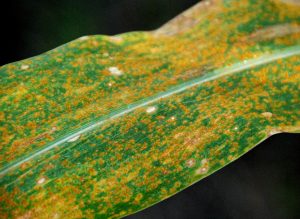
Features:
Southern Rust, caused by the fungus Puccinia polysora, is a significant disease in warm, humid corn-growing regions. It spreads rapidly under favorable conditions, leading to severe yield losses.
Symptoms:
Southern Rust is identified by the presence of small, circular, orange to reddish-brown pustules primarily on the upper leaf surfaces. Unlike Common Rust, these pustules are more densely clustered. Severe infections can cause premature leaf senescence, reduced photosynthetic capacity, and significant yield reduction.
Management:
Effective management includes planting resistant hybrids and applying fungicides during periods of high disease pressure. Products containing strobilurins, triazoles, or a combination can be effective. Crop rotation and good field sanitation practices can help reduce the inoculum level. Regular scouting and early detection are essential for timely intervention and minimizing the impact of Southern Rust.
Solution:
To manage Southern rust effectively, incorporating biological fungicides can provide a sustainable and eco-friendly solution. Products like Bacillus subtilis and Bacillus velezensis are excellent choices for combating this disease.
-
Bacillus subtilis:
This beneficial bacterium acts as a biological fungicide by colonizing the leaf surface and creating a protective barrier against pathogens. It competes with the rust fungus for space and nutrients, thereby inhibiting its growth and spread. Additionally, Bacillus subtilis induces systemic resistance in the plant, enhancing its natural defense mechanisms against a wide range of diseases, including Southern rust.
-
Bacillus velezensis:
Another effective biological control agent, Bacillus velezensis, provides robust protection against Southern rust. This bacterium produces antimicrobial compounds that directly target and suppress the rust fungus. By promoting plant health and boosting the plant’s immune response, Bacillus velezensis helps to prevent infection and reduce the severity of disease outbreaks.
By integrating Bacillus subtilis and Bacillus velezensis into a comprehensive disease management strategy, farmers can effectively control Southern rust and protect their corn crops. These biological solutions not only minimize the impact of the disease but also promote sustainable and environmentally friendly farming practices.
Anthracnose Leaf Blight and Stalk Rot (Colletotrichum graminicola)
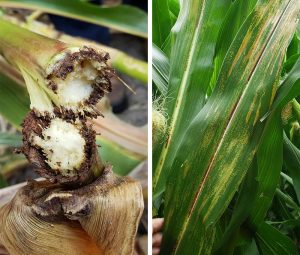
Features:
Anthracnose, caused by the fungus Colletotrichum graminicola, affects both leaves and stalks of corn plants. The disease thrives in warm, humid environments and can lead to significant yield losses.
Symptoms:
Anthracnose Leaf Blight is characterized by small, water-soaked lesions on the lower leaves, which turn brown with age. Stalk Rot manifests as black, shiny lesions on the stalks, often leading to stalk breakage. Affected plants may exhibit wilting, stunted growth, and reduced ear size.
Management:
To manage Anthracnose, use resistant hybrids and implement crop rotation with non-host plants. Ensure proper crop residue management to reduce pathogen survival. Fungicide applications can help control Leaf Blight, particularly during conditions favorable for disease development. Products containing strobilurins or triazoles are effective. Regular scouting and early detection are crucial for timely intervention and minimizing the impact of Anthracnose.
Solution:
To manage Anthracnose Leaf Blight and Stalk Rot effectively, incorporating biological solutions like Trianum Shield can be highly beneficial. Trianum-Shield is a bio-fungicide containing the beneficial fungus Trichoderma harzianum, which promotes plant health by enhancing root development and providing a protective barrier against pathogens. Trichoderma harzianum outcompetes harmful fungi and stimulates the plant’s immune response, thereby reducing the incidence of both leaf blight and stalk rot. By integrating Trianum-Shield into a comprehensive disease management strategy, farmers can protect their corn crops from Anthracnose, ensuring healthier plants and better yields.
Fusarium Ear Rot (Fusarium verticillioides)
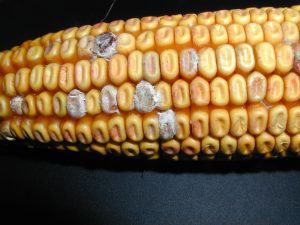
Features:
Fusarium Ear Rot, caused by the fungus Fusarium verticillioides, is a common disease in corn that thrives in warm, humid conditions. The pathogen can produce mycotoxins, posing a risk to livestock and human health.
Symptoms:
The disease is characterized by the presence of white to pinkish mold on the kernels, often starting at the ear tip and progressing downward. Infected kernels may become discolored, shriveled, and lightweight. Severely affected ears can exhibit poor grain quality and reduced yield.
Management:
Effective management includes planting resistant hybrids and ensuring proper crop rotation to break the disease cycle. Fungicide applications can help control the disease, particularly during periods of high moisture. Products containing strobilurins or triazoles are effective. Regular scouting and early detection are crucial for timely intervention and minimizing the impact of Fusarium Ear Rot.
Solution:
To manage Fusarium Ear Rot effectively, a combined approach involving biological solutions can be highly effective. Products like Trianum Shield offer sustainable solutions. Trianum Shield contains beneficial fungi, specifically Trichoderma harzianum, which promote plant health by enhancing root development and providing a protective barrier against pathogens. Trichoderma harzianum acts as a biological control agent, combating Fusarium Ear Rot by outcompeting harmful fungi and stimulating the plant’s immune response. By incorporating Trianum Shield into a comprehensive disease management strategy, corn growers can minimize the impact of Fusarium Ear Rot and promote healthier, more productive crops. Regular application of Trianum Shield, particularly during the early stages of ear development, can significantly reduce disease incidence and ensure better grain quality.
Diplodia Ear Rot (Stenocarpella maydis)
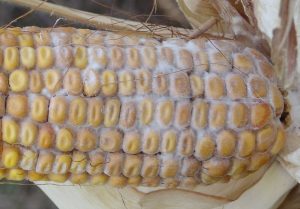
Features:
Diplodia Ear Rot, caused by the fungus Stenocarpella maydis, is a prevalent disease in corn that thrives in wet conditions. The pathogen can survive in crop debris, making it a persistent issue in continuous corn cropping systems.
Symptoms:
The disease manifests as white mold growth on the ear, often starting at the base and progressing upward. Infected kernels become lightweight, discolored, and may contain black fungal structures. Severely affected ears can exhibit poor grain quality and significant yield loss.
Management:
To manage Diplodia Ear Rot, implement crop rotation with non-host plants and ensure proper crop residue management. Fungicide applications can help control the disease, particularly during periods of high moisture. Products containing strobilurins or triazoles are effective. Regular scouting and early detection are crucial for timely intervention and minimizing the impact of Diplodia Ear Rot.
Solution:
To manage Diplodia Ear Rot effectively, a combined approach involving biological solutions can be highly effective. Products like Trichoderma harzianum and Bacillus subtilis offer sustainable solutions.
-
Trichoderma harzianum:
This beneficial fungus acts as a biological control agent by colonizing the root zone and outcompeting harmful fungi likeStenocarpella maydis. Trichoderma harzianum also promotes plant health by enhancing root development and providing a protective barrier against pathogens. Regular application of Trichoderma harzianum can help reduce the incidence of Diplodia Ear Rot and improve overall crop health.
-
Bacillus subtilis:
This beneficial bacterium is another effective biological control agent that combats Diplodia Ear Rot by producing antibiotics and enzymes that inhibit fungal growth. Bacillus subtilis also induces systemic resistance in plants, enhancing their natural defense mechanisms against a wide range of pathogens. By incorporating Bacillus subtilis into a comprehensive disease management strategy, farmers can effectively reduce the impact of Diplodia Ear Rot and promote healthier corn crops.
By integrating these biological solutions into an integrated pest management strategy, corn growers can achieve sustainable and effective control of Diplodia Ear Rot, ensuring healthier and more productive corn fields.
Gibberella Ear Rot (Gibberella zeae)
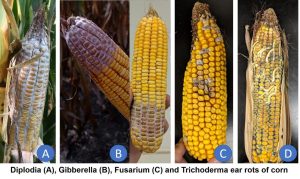
Features:
Gibberella Ear Rot, caused by the fungus Gibberella zeae, is a common disease in corn that thrives in cool, wet conditions. The pathogen can produce mycotoxins, posing a risk to livestock and human health.
Symptoms:
The disease is characterized by the presence of pink to reddish mold on the kernels, often starting at the ear tip and progressing downward. Infected kernels may become discolored, shriveled, and lightweight. Severely affected ears can exhibit poor grain quality and reduced yield.
Management:
Effective management includes planting resistant hybrids and ensuring proper crop rotation to break the disease cycle. Fungicide applications can help control the disease, particularly during periods of high moisture. Products containing strobilurins or triazoles are effective. Regular scouting and early detection are crucial for timely intervention and minimizing the impact of Gibberella Ear Rot.
Solution:
To manage Gibberella Ear Rot effectively, incorporating biological solutions like Trichoderma harzianum and Bacillus subtilis can be highly effective.
-
Trichoderma harzianum:
Trichoderma harzianum is a beneficial fungus that acts as a biological control agent against Gibberella Ear Rot. It colonizes the root zone and the surface of the corn plants, outcompeting and inhibiting the growth of Fusarium graminearum. Trichoderma harzianum enhances plant health by promoting root development and inducing systemic resistance, making the plants more resilient to fungal infections. For more information about Trichoderma harzianum and its application, you can visit the product page.
-
Bacillus subtilis:
Bacillus subtilis is another effective biological fungicide that helps manage Gibberella Ear Rot. This bacterium produces antifungal compounds that suppress the growth of Fusarium graminearum. Bacillus subtilis also enhances the plant’s natural defense mechanisms, providing an additional layer of protection against the disease. Regular application of Bacillus subtilis can reduce disease severity and improve overall crop health. To learn more about Bacillus subtilis and its benefits, check out the product page.
By integrating these biological solutions into a comprehensive disease management strategy, farmers can effectively control Gibberella Ear Rot and ensure healthier, more productive corn crops.
Aspergillus Ear Rot (Aspergillus flavus)
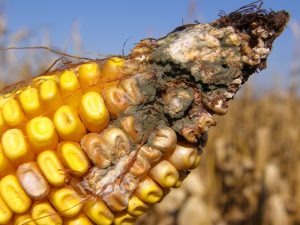
Features:
Aspergillus Ear Rot, caused by the fungus Aspergillus flavus, is a significant disease in corn that thrives in hot, dry conditions. The pathogen can produce aflatoxins, posing a risk to livestock and human health.
Symptoms:
The disease is characterized by the presence of yellow-green mold on the kernels, often starting at the ear tip and progressing downward. Infected kernels may become discolored, shriveled, and lightweight. Severely affected ears can exhibit poor grain quality and significant yield loss.
Management:
To manage Aspergillus Ear Rot, plant resistant hybrids and ensure proper crop rotation to break the disease cycle. Fungicide applications can help control the disease, particularly during periods of high moisture. Products containing strobilurins or triazoles are effective. Regular scouting and early detection are crucial for timely intervention and minimizing the impact of Aspergillus Ear Rot.
Solution:
To manage Aspergillus ear rot effectively, integrating biological solutions can provide sustainable and long-lasting control. Products like Trichoderma harzianum and Bacillus subtilis offer effective management options.Trichoderma harzianumis a beneficial fungus that colonizes the root zone, enhancing plant health by outcompeting pathogenic fungi and inducing systemic resistance in plants. This fungus creates a protective barrier, reducing the impact of Aspergillus ear rot on corn crops.
Similarly, Bacillus subtilis is a beneficial bacterium that acts as a biological fungicide. Bacillus subtilis suppresses fungal pathogens through competitive exclusion and the production of antimicrobial compounds. When applied to corn plants, it enhances the plant’s immune response and protects against fungal infections, including Aspergillus ear rot. By incorporating Trichoderma harzianum and Bacillus subtilis into an integrated disease management strategy, farmers can effectively mitigate the risks associated with Aspergillus ear rot, ensuring healthier and safer corn harvests.
Corn Root Knot Nematode
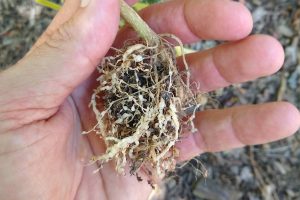
Features:
Corn root knot nematodes are microscopic roundworms that attack corn roots, causing the formation of galls or knots. These pests disrupt the plant’s ability to absorb water and nutrients, leading to stunted growth and reduced yield. Infestations are often more severe in sandy soils and can persist in the soil for several years, affecting successive crops.
Symptoms:
Infected corn plants exhibit symptoms such as yellowing of leaves, stunted growth, and wilting, particularly during hot, dry conditions. The presence of galls on the roots is a telltale sign of nematode infestation. These root galls hinder nutrient uptake, leading to poor plant health and reduced kernel quality.
Management:
Effective management of corn root knot nematodes involves a combination of cultural practices, biological control, and chemical treatments. Rotating crops with non-host species, maintaining soil health through organic amendments, and using resistant corn varieties can help reduce nematode populations.
Solution:
To manage corn root knot nematode infestations effectively, incorporating biological solutions such as Nema ProMax or Nema Pro can be highly effective.
Nema ProMax is a liquid bio-nematicide that contains beneficial bacteria, specifically Burkholderia spp., which target and suppress nematode populations. This product promotes healthy root growth by protecting the roots from nematode damage and enhancing the plant’s natural defenses.
Nema Pro is another effective biological nematicide that utilizes beneficial microorganisms to combat nematodes. It works by colonizing the root zone and creating a hostile environment for nematodes, thereby reducing their impact on the crop.
Both Nema ProMax and Nema Pro are environmentally friendly options that integrate well into an overall nematode management strategy. Regular application of these products, along with crop rotation and soil health practices, can significantly reduce nematode populations and protect corn crops from damage, leading to healthier plants and improved yields.
Corn Cyst Nematode
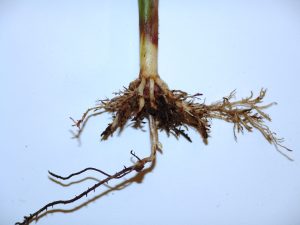
Features:
Corn cyst nematodes are soil-dwelling pests that predominantly attack the roots of corn plants. These nematodes form cysts that house eggs, which hatch and invade the root system. The damage caused by corn cyst nematodes includes stunted growth, poor root development, and reduced nutrient uptake, severely impacting plant health and yield.
Symptoms:
Corn plants infested with corn cyst nematodes exhibit symptoms such as yellowing leaves, stunted growth, and poor root structure. Infected roots often show galls or cysts, and the overall vigor of the plant is significantly diminished. These symptoms can lead to reduced crop yield and quality, making early detection and management critical.
Management:
Effective management of corn cyst nematodes involves a combination of cultural practices and biological control methods. Crop rotation with non-host crops can help break the nematode life cycle, reducing their population in the soil. Regular soil testing and nematode population monitoring are essential to identify infestation levels and implement timely management strategies.
Solution:
To manage corn cyst nematode infestations effectively, incorporating biological solutions can be highly beneficial. Products like Nema Pro Max and Nema Pro offer sustainable and effective options.
Nema ProMax is a liquid bio-nematicide containing beneficial bacteria, Burkholderia spp., which target and suppress nematode populations in the soil. This product enhances soil health and promotes root development, providing a protective barrier against nematode invasion.
Similarly, Nema Pro is another highly effective bio-nematicide that works by enhancing the plant’s natural defenses and creating an unfavorable environment for nematodes. Both products are environmentally friendly and can be integrated into a comprehensive nematode management strategy.
By incorporating Nema ProMax or Nema Pro into their pest management plans, farmers can effectively control corn cyst nematode populations and promote healthier, more productive corn crops. Regular application, combined with cultural practices such as crop rotation, ensures optimal results and sustainable crop protection.
Corn Lesion Nematode
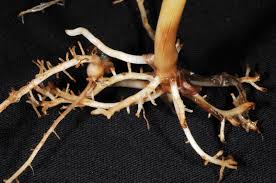
Features:
Corn lesion nematodes are microscopic roundworms that invade the roots of corn plants, causing significant damage. These nematodes are capable of surviving in a wide range of soils and can persist in crop residues. They penetrate root tissues, creating lesions that can lead to secondary infections by other soil-borne pathogens.
Symptoms:
Infected corn plants exhibit stunted growth, chlorosis (yellowing of leaves), and poor root development. The characteristic lesions on the roots are dark, elongated, and can become necrotic. This root damage impairs the plant’s ability to absorb water and nutrients, leading to reduced yield and overall plant health.
Management:
Effective management of corn lesion nematodes involves a combination of cultural practices and biological control methods. Rotating crops with non-host plants, such as small grains or legumes, can help reduce nematode populations in the soil. Additionally, maintaining healthy soil through organic amendments and proper irrigation practices can improve plant resilience against nematodes.
Solution:
To manage corn lesion nematodes effectively, incorporating biological nematicides into your pest management strategy can be highly beneficial. Products like Nema Pro Max and Nema Pro offer sustainable solutions. Nema ProMax contains beneficial microbes that enhance soil health and suppress nematode populations by outcompeting them and producing natural toxins. Similarly, Nema Pro is a biological nematicide that targets nematodes directly, reducing their numbers and mitigating root damage. By applying these products as part of an integrated pest management plan, farmers can effectively control corn lesion nematodes, promote healthier root systems, and improve overall crop yield and quality. Regular soil monitoring and timely application of these biological controls can ensure optimal results and sustainable corn production.
Nutrition Management in Organic Corn
Nutrition management in organic corn production is a critical aspect of achieving healthy growth and optimal yields. Organic practices emphasize the use of natural and sustainable inputs to nourish the soil and plants. This includes incorporating organic matter such as compost, manure, and cover crops to enhance soil fertility and structure. Regular soil testing is essential to identify nutrient deficiencies and adjust inputs accordingly. Nitrogen, a key nutrient for corn, can be supplied through legume cover crops, green manures, and approved organic fertilizers like blood meal or fish emulsion. Maintaining balanced levels of phosphorus and potassium is also crucial, achievable through rock phosphate and potassium sulfate applications. Additionally, crop rotation and intercropping with legumes can improve soil health and nutrient availability. By adhering to organic principles and practices, farmers can effectively manage nutrition in corn crops, promoting vigorous growth and high-quality yields while sustaining the environment.
Solutions for Essential Nutrients
Nitrogen for Corn
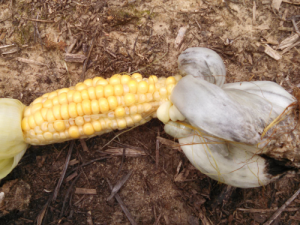 One of the most effective solutions for supplying nitrogen in organic corn production is METILO. METILO provides an organic source of nitrogen, essential for promoting vigorous growth and healthy foliage in corn plants. It helps in the breakdown of organic matter, releasing nitrogen in a form that plants can readily absorb. By enhancing nitrogen availability, METILO supports robust plant development and boosts overall crop productivity, contributing to sustainable farming practices by minimizing the need for synthetic fertilizers.
One of the most effective solutions for supplying nitrogen in organic corn production is METILO. METILO provides an organic source of nitrogen, essential for promoting vigorous growth and healthy foliage in corn plants. It helps in the breakdown of organic matter, releasing nitrogen in a form that plants can readily absorb. By enhancing nitrogen availability, METILO supports robust plant development and boosts overall crop productivity, contributing to sustainable farming practices by minimizing the need for synthetic fertilizers.
Phosphorus for Corn
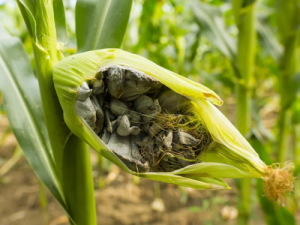 For phosphorus management, Cropium is an excellent solution.Cropium enhances phosphorus availability in the soil, which is vital for root development and energy transfer within the plant. By using Cropium, farmers can ensure their corn crops receive the necessary phosphorus for optimal growth. This advanced agricultural product promotes efficient nutrient use, resulting in healthier plants and higher yields, while also reducing dependence on traditional phosphorus-based fertilizers.
For phosphorus management, Cropium is an excellent solution.Cropium enhances phosphorus availability in the soil, which is vital for root development and energy transfer within the plant. By using Cropium, farmers can ensure their corn crops receive the necessary phosphorus for optimal growth. This advanced agricultural product promotes efficient nutrient use, resulting in healthier plants and higher yields, while also reducing dependence on traditional phosphorus-based fertilizers.
Potassium and Silicon Nutrients for Corn
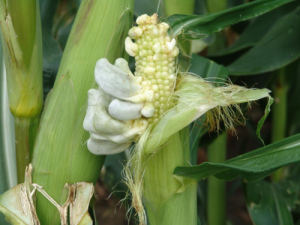 Bacillus mucilaginosus is a beneficial bacterium that solubilizes potassium and releases silicon in the soil, making these nutrients available to corn plants.Potassium is crucial for overall plant health and disease resistance, while silicon strengthens plant tissues, enhancing their ability to withstand stress. By incorporating Bacillus mucilaginosus into their soil management practices, farmers can improve nutrient availability and support the resilience and vigor of their corn crops.
Bacillus mucilaginosus is a beneficial bacterium that solubilizes potassium and releases silicon in the soil, making these nutrients available to corn plants.Potassium is crucial for overall plant health and disease resistance, while silicon strengthens plant tissues, enhancing their ability to withstand stress. By incorporating Bacillus mucilaginosus into their soil management practices, farmers can improve nutrient availability and support the resilience and vigor of their corn crops.
Soil Amendment and Growth Stimulation
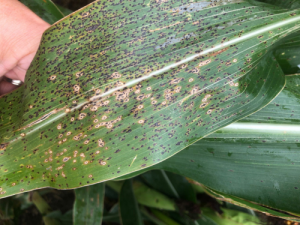 Soil Vigor is an excellent product for soil amendment and growth stimulation.It contains a blend of beneficial microorganisms that improve soil structure, enhance nutrient uptake, and stimulate plant growth. Using Soil Vigor ensures a healthy and fertile soil environment, promoting robust corn growth. This biological approach to soil management fosters a dynamic and productive ecosystem, supporting long-term agricultural sustainability and reducing the reliance on chemical inputs.
Soil Vigor is an excellent product for soil amendment and growth stimulation.It contains a blend of beneficial microorganisms that improve soil structure, enhance nutrient uptake, and stimulate plant growth. Using Soil Vigor ensures a healthy and fertile soil environment, promoting robust corn growth. This biological approach to soil management fosters a dynamic and productive ecosystem, supporting long-term agricultural sustainability and reducing the reliance on chemical inputs.
Integrated Pest Management (IPM) Practices for Corn Growing
Integrated Pest Management (IPM) is a holistic approach to managing pests and diseases in corn production, combining multiple strategies to achieve sustainable and effective control. IPM emphasizes the use of biological controls, cultural practices, resistant varieties, and judicious use of chemical interventions to minimize pest damage while preserving the environment. By integrating these methods, farmers can maintain healthy crops, reduce the reliance on chemical pesticides, and promote long-term agricultural sustainability.
Key IPM Practices for Corn Growing:
- Biological Controls: Utilizing natural predators, parasitoids, and pathogens to control pest populations is a cornerstone of IPM. For example, introducing beneficial insects like ladybugs and lacewings can help manage aphid populations, while Bacillus thuringiensis (Bt) and other microbial insecticides can target specific pests like corn earworms without harming beneficial species.
- Cultural Practices: These include techniques such as crop rotation, intercropping, and the use of trap crops to disrupt pest life cycles and reduce their impact. Proper irrigation, sanitation, and maintaining healthy soil through organic amendments also contribute to a robust IPM strategy.
- Resistant Varieties: Planting corn varieties that are genetically resistant to certain pests and diseases can significantly reduce the need for chemical treatments. Resistant varieties have been developed to withstand threats such as corn rootworms and Northern Corn Leaf Blight, enhancing crop resilience and yield.
- Monitoring and Scouting: Regular monitoring of pest and disease levels through field scouting and using tools like pheromone traps and remote sensing technology allows for early detection and timely intervention. This proactive approach helps in applying targeted treatments and preventing outbreaks.
- Chemical Controls: When necessary, the use of chemical pesticides is incorporated into IPM in a targeted and judicious manner. By rotating different classes of chemicals and applying them based on monitoring data, farmers can prevent the development of pest resistance and minimize environmental impact.
Conclusion
In conclusion, integrated pest management (IPM) practices for corn growing are essential for maintaining crop health, maximizing yields, and promoting sustainable agriculture. Crop rotation plays a critical role in disrupting pest life cycles and improving soil fertility, while biological controls offer environmentally friendly solutions to manage pest populations. The use of resistant varieties enhances the plant’s natural defenses against pests and diseases, reducing the need for chemical interventions. By adopting these IPM practices, farmers can achieve a balanced and sustainable approach to pest management, ensuring the long-term productivity and health of their corn crops.
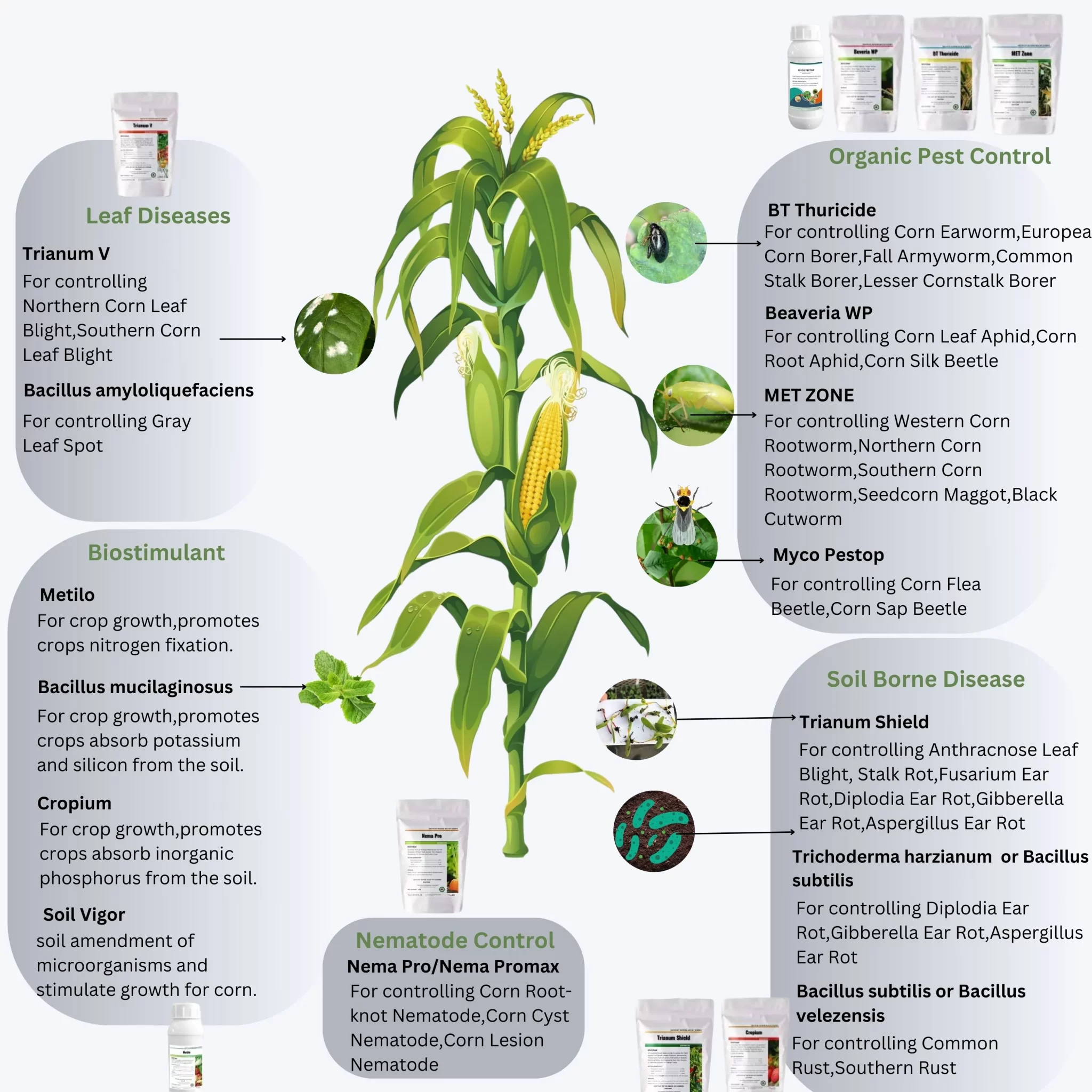
Related Products
CONTACT US

Office 38/1502, No 660,Hanguang Rt., Changsha City, Hunan, China




































